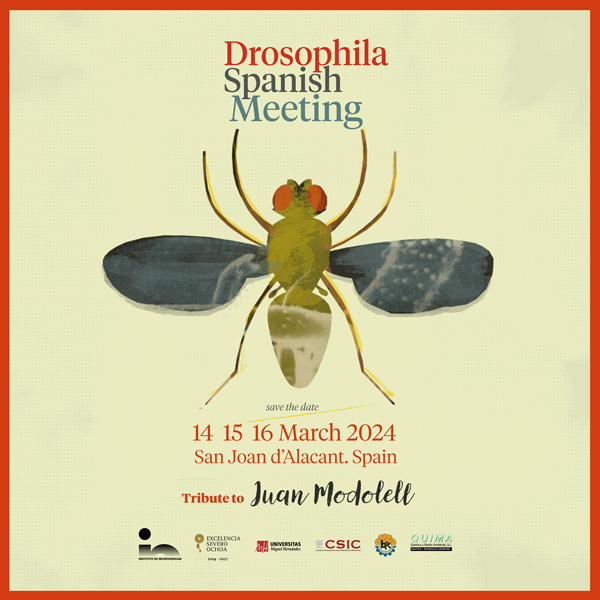Líneas de investigación
El objetivo del grupo se centra en entender como el comportamiento emerge de la actividad combinada de redes neuronales. Nos centramos en el estudio de la integración sensorial y procesos de toma de decisiones usando como modelo el sistema gustativo de Drosophila melanogaster, gracias a que este sistema es fácilmente manipulable a nivel genético, analizar a nivel comportamental y analizar la actividad neuronal in vivo. El laboratorio usa una combinación de técnicas trazado de neuronas, imagen, inmunohistoquímica y comportamiento.
Publicaciones relevantes
- Molecular characterization of gustatory second-order neurons reveals integrative mechanisms of gustatory and metabolic information. Mollá-Albaladejo R, Jiménez-Caballero M and Sánchez-Alcañiz JA#. # Corresponding author. eLife. 2024 (under review) https://doi.org/10.7554/elife.100947
- Evolution of chemosensory tissues and cells across ecologically diverse Drosophila. Bontonou G, Saint-Leandre B, Kafle T, Baticle T, Hassan A, Sánchez-Alcañiz JA and Arguello RJ. Nature Communications. 2024 15, 1047 (2024) https://doi.org/10.1038/s41467-023-44558-4
- Behavior Individuality: A Focus on Drosophila melanogaster Molla-Albaladejo R, Sanchez-Alcaniz JA Front Physiol 2021 12: 719038 https://doi.org/10.3389/fphys.2021.719038
- An expression atlas of variant ionotropic glutamate receptors identifies a molecular basis of carbonation sensing Sánchez-Alcañiz JA, Silbering AF, Croset V, Zappia G, Sivasubramaniam AK, Abuin L, Sahai SY, Münch D, Steck K, Auer TO, Cruchet S, Neagu-Maier GL, Sprecher SG, Ribeiro C, Yapici N, Benton R. Nat Commun 2018 9(1):4252 https://doi.org/10.1038/s41467-018-06453-1
- A mechanosensory receptor required for food texture detection in Drosophila Juan Antonio Sánchez-Alcañiz , Giovanna Zappia , Frédéric Marion-Poll , Richard Benton Nat Commun 2017 8:14192 https://doi.org/10.1038/ncomms14192
- Neuregulin 3 Mediates Cortical Plate Invasion and Laminar Allocation of GABAergic Interneurons Bartolini G, Sanchez-Alcaniz JA, Osorio C, Valiente M, Garcia-Frigola C, Marin O Cell Rep 2017 18(5):1157 https://doi.org/10.1016/j.celrep.2016.12.089
Investigador emergente
Investigador postdoctoral
- Molecular characterization of gustatory second-order neurons reveals integrative mechanisms of gustatory and metabolic information. Mollá-Albaladejo R, Jiménez-Caballero M and Sánchez-Alcañiz JA#. # Corresponding author. eLife. 2024 (under review) https://doi.org/10.7554/elife.100947
- Evolution of chemosensory tissues and cells across ecologically diverse Drosophila. Bontonou G, Saint-Leandre B, Kafle T, Baticle T, Hassan A, Sánchez-Alcañiz JA and Arguello RJ. Nature Communications. 2024 15, 1047 (2024) https://doi.org/10.1038/s41467-023-44558-4
- Behavior Individuality: A Focus on Drosophila melanogaster Molla-Albaladejo R, Sanchez-Alcaniz JA Front Physiol 2021 12: 719038 https://doi.org/10.3389/fphys.2021.719038
- An expression atlas of variant ionotropic glutamate receptors identifies a molecular basis of carbonation sensing Sánchez-Alcañiz JA, Silbering AF, Croset V, Zappia G, Sivasubramaniam AK, Abuin L, Sahai SY, Münch D, Steck K, Auer TO, Cruchet S, Neagu-Maier GL, Sprecher SG, Ribeiro C, Yapici N, Benton R. Nat Commun 2018 9(1):4252 https://doi.org/10.1038/s41467-018-06453-1
- A mechanosensory receptor required for food texture detection in Drosophila Juan Antonio Sánchez-Alcañiz , Giovanna Zappia , Frédéric Marion-Poll , Richard Benton Nat Commun 2017 8:14192 https://doi.org/10.1038/ncomms14192
- Neuregulin 3 Mediates Cortical Plate Invasion and Laminar Allocation of GABAergic Interneurons Bartolini G, Sanchez-Alcaniz JA, Osorio C, Valiente M, Garcia-Frigola C, Marin O Cell Rep 2017 18(5):1157 https://doi.org/10.1016/j.celrep.2016.12.089
- Cxcr7 Controls Neuronal Migration by Regulating Chemokine Responsiveness Sanchez-Alcaniz JA, Haege S, Mueller W, Pla R, Mackay F, Schulz S, Lopez-Bendito G, Stumm R, Marin O Neuron 2011 69(1):77 https://doi.org/10.1016/j.neuron.2010.12.006

 English
English
